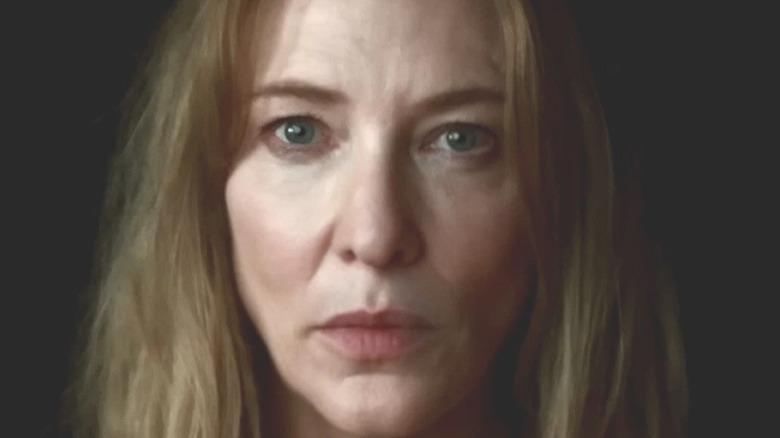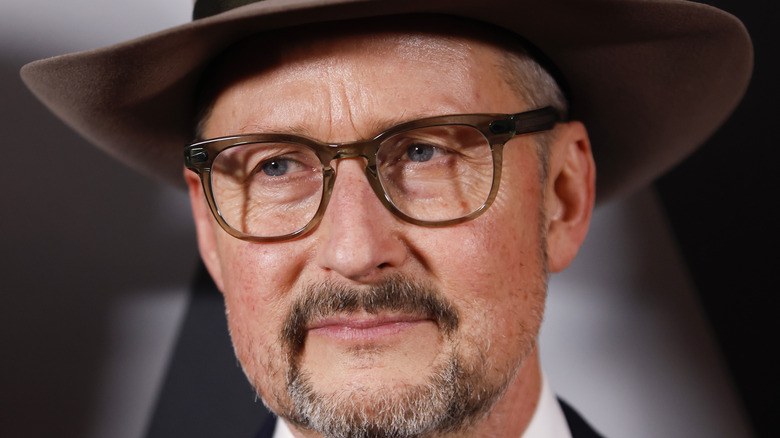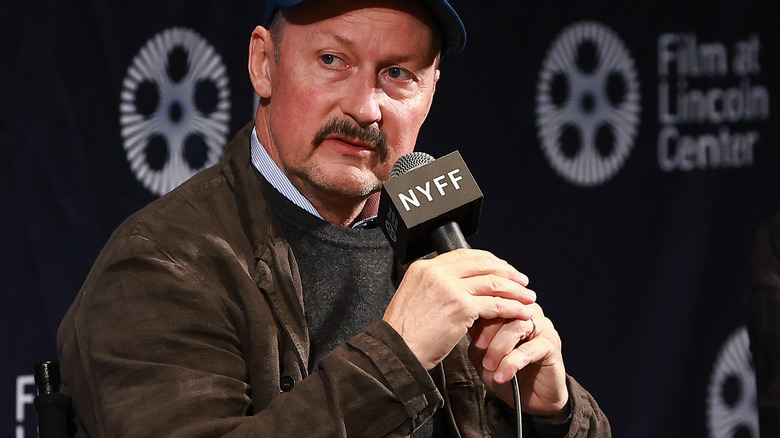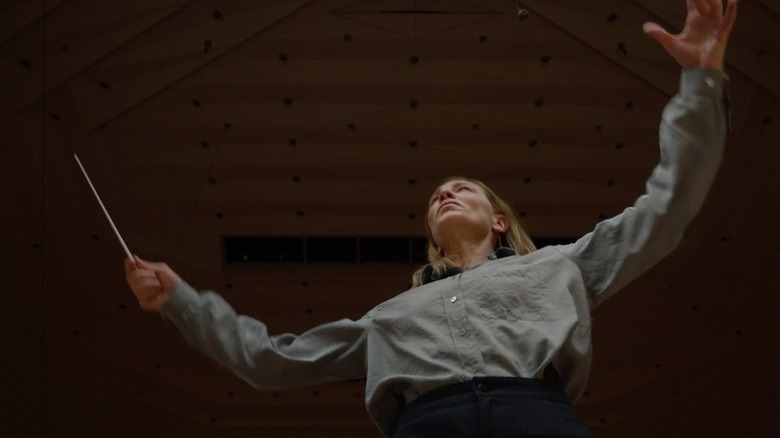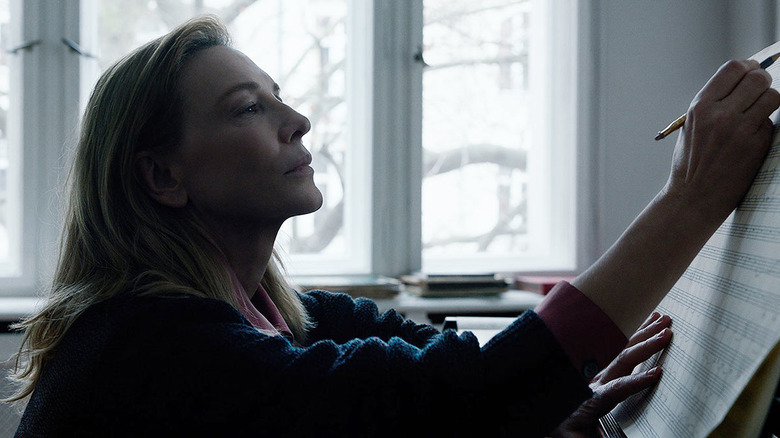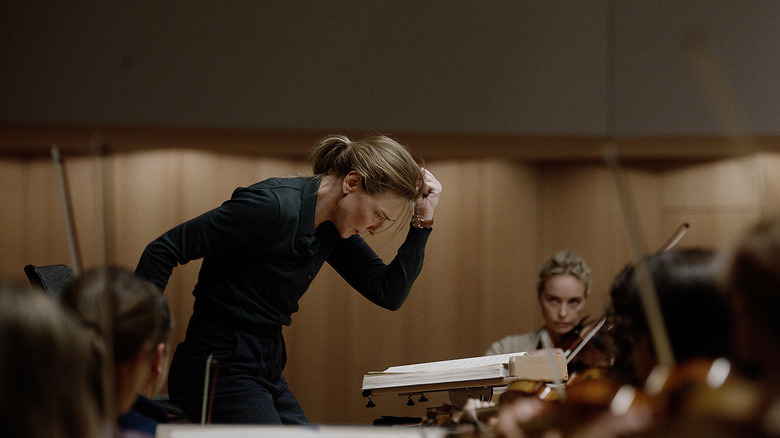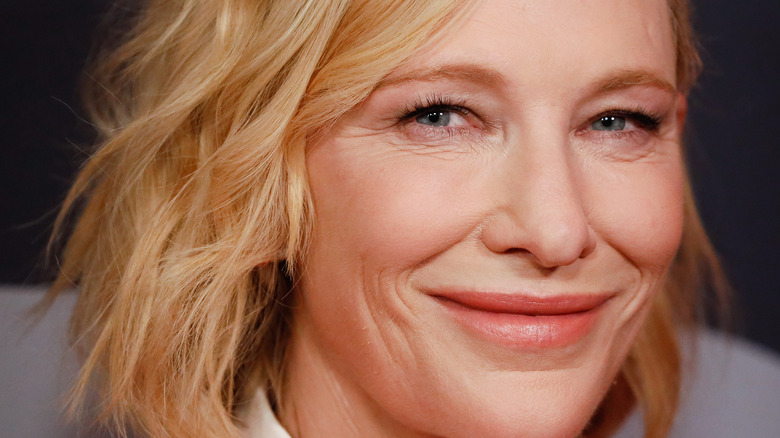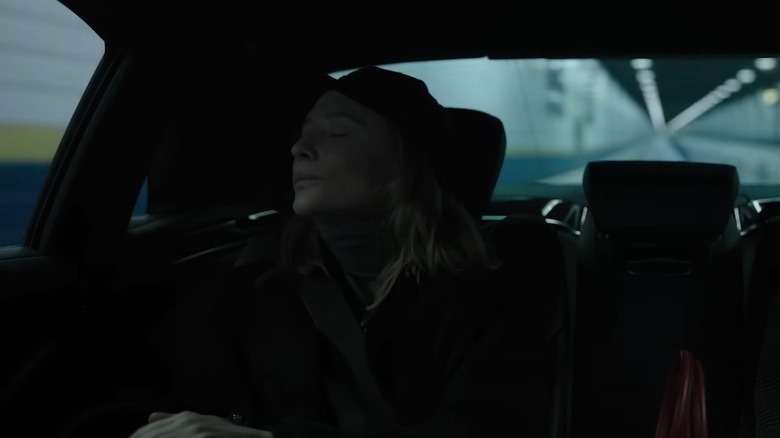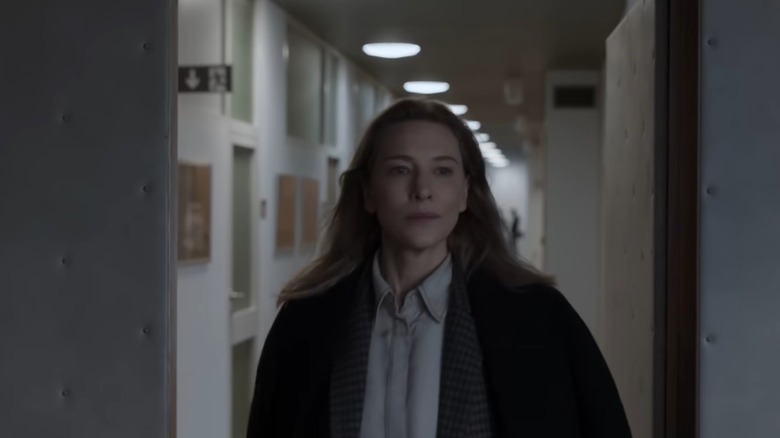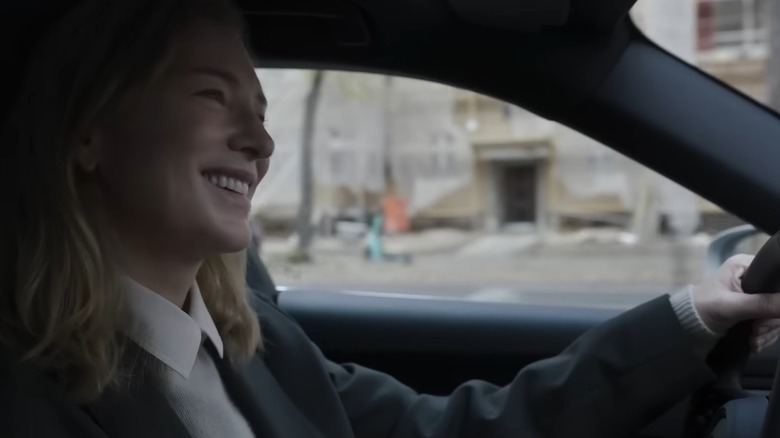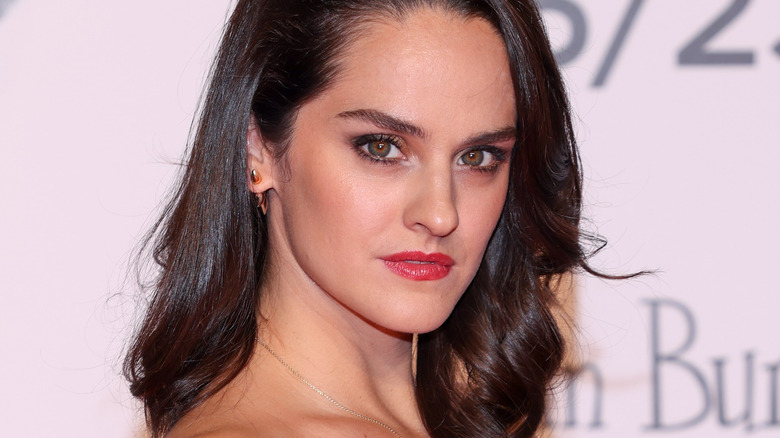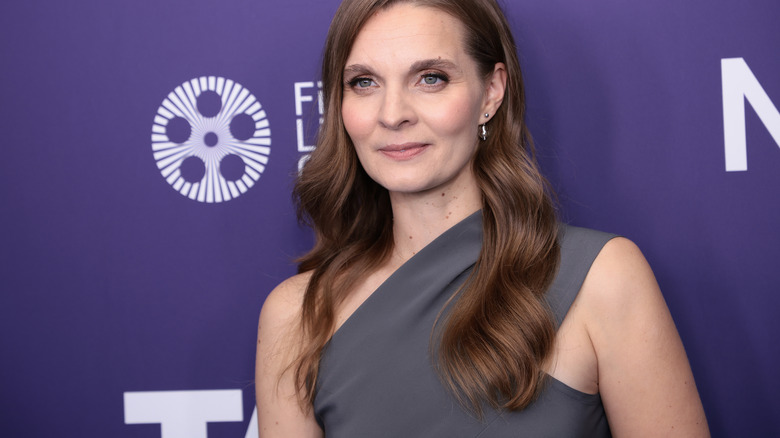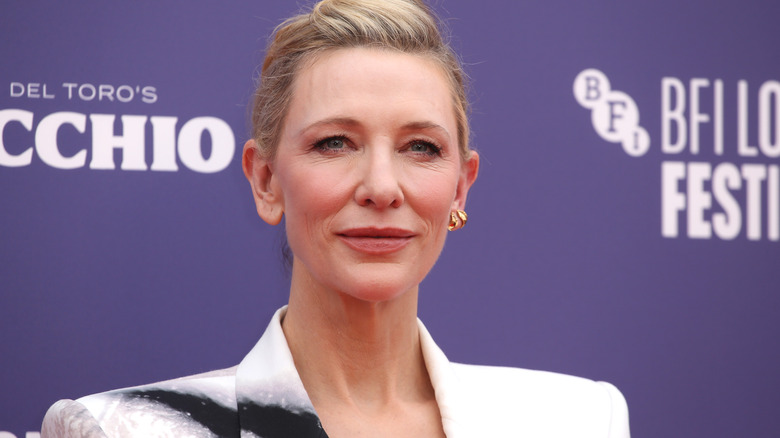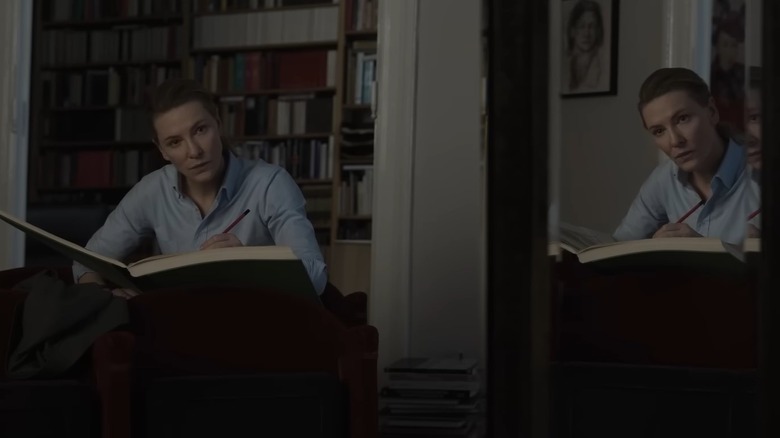Tár: 14 Facts About Cate Blanchett's Critical Hit That Will Be Music To Your Ears
As the Cate Blanchett star vehicle "Tár" unfurls before the viewer, it can be hard to parse out just what this film is doing. Writer-director Todd Field is stridently against spoon-feeding things to the audience that it can be difficult to figure out if this feature is planning to offer more than just the day-to-day existence of famed composer Lydia Tár (Blanchett). But "Tár" gradually reveals itself to be a tour de force of cinematic storytelling, one with many ideas regarding how power is wielded in the world of art. Though restrained in its cinematography, "Tár" still gives viewers a lot of bang for their buck.
"Tár" is a richly-detailed work that begs for revisits and in-depth conversations about its finer intricacies. This collection of facts about "Tár" help paint a picture of just how much effort was put into this deeply unique motion picture. Exploring these details about "Tár" underscores the craftsmanship that made this such an extraordinary movie.
The origins of Tár
For many challenging dramas from acclaimed auteurs, it's a struggle to ever get the support you need to make your vision a reality. Just look at Martin Scorsese's "The Irishman," which floundered for years because no studio would dare give Scorsese money to bring his passion project to life. This precedent would make it seem inevitable that a film like Todd Field's "Tár" would end up being a near-impossible film to garner any studio support for ... but that's not quite what happened.
Field explained to Variety that the genesis for "Tár" came from the chairman of Focus Features, Peter Kujawski, reaching out to Field and saying that this studio was interested in supporting anything Field wanted to write about. Shocked and pleased at that level of passion, Field was determined to craft something that could live up to the creative flexibility afforded by Focus Features. Field further recalled to The Playlist that he was certain, once Focus saw the first script for "Tár", they wouldn't want to support the project anymore. Instead, the executive team remained steadfast in supporting Field, to the point that they offered no notes on the script. This was a rare but incredibly welcome turn of events for an original adult drama in the modern cinematic landscape.
How Todd Field felt getting back to directing movies with Tár
In the 2000s, Todd Field made an incredible splash as a director. "In the Bedroom" and "Little Children" both signaled the arrival of a remarkable auteur. After "Little Children" in 2006, Field suddenly vanished from the world of filmmaking. A bright fresh creative voice had gone quiet. It took 16 years, but Field would make a bold return to movies by writing and directing "Tár." The precise nature of Field's previous work was fully intact here, combined with variations such as a collection of European backdrops that weren't present in his previous films.
In his time away from directing feature-length movies, Field hadn't missed a beat as an artist. Field noted to AwardsWatch that one thing that helped him get back into the groove of this style of filmmaking was that he spent the time between "Little Children" and "Tár" directing in the business world. While those projects ensured he never lost his eye for filmmaking, they certainly didn't give him the chance to work with actors like Cate Blanchett. Collaborating with those sorts of performers again was the most satisfying aspect of Field's return to cinema, making his experience directing "Tár" as memorable as watching the final film was for general audiences.
Todd Field's research process for Tár
"Tár" is such a singular cinematic experience that it can be hard to comprehend what kind of research writer-director Todd Field did for this feature. How could studying books or looking at real people ever produce the kind of unprecedented scenes of suspense or bottled-up torment that are peppered throughout "Tár?" It seems like a movie that just emerged from the void fully formed. Yet Field did indeed do his homework when it came to realizing the world of an immensely influential composer, with all that research paying off richly when he was directing.
Field recounted to AwardsWatch that his primary period of research was right at the start of the COVID-19 pandemic when he was trapped indoors and engaged in around four weeks of arduous research about the modern conducting scene. Field also turned to conductor John Mauceri for advice and guidance to ensure that "Tár" felt like it occupied reality rather than a sanitized movie version of what it's like being a conductor. It was especially important for Field to make sure that Lydia Tár came across as somebody who was convincing as an expert in her artistic field. Even if the movie itself feels unprecedented, "Tár" was built on so much research and countless cues from the real world.
Lydia Tár was written with Cate Blanchett in mind
It takes only a few minutes of watching Lydia Tár before it's impossible to ever conceive of anybody but Cate Blanchett in the role. Blanchett doesn't need layers of prosthetics or a drastic physical transformation to become Tár. The pervasive confidence that she exudes in portraying Lydia Tár is especially unique in the pantheon of Blanchett roles. She always finds such fascinating ways to quietly suggest how Tár has become accustomed to being in full control of her universe. That's just one of the many aspects of Blanchett's work in "Tár" that resonates as truly spellbinding, and it's no surprise such a quality performance was always crafted with this performer in mind.
Writer-director Todd Field revealed to The Playlist that he'd made a bold gamble by writing this conductor for Cate Blanchett even though she wasn't attached to the feature in any way. If she didn't sign on or spark to the script, "Tár" was going to be in deep trouble. Luckily, not only did Blanchett immediately connect with this feature, she and Field quickly became close artistic collaborators in further fleshing out the interior world of Lydia Tár. Considering how closely this character was built from the ground up to connect to Blanchett, it's no surprise that her performance as Lydia Tár is magnificent.
Why do the end credits of Tár show up at the start of the movie?
"Tár" immediately establishes its status as a deeply idiosyncratic slice of arthouse cinema by kicking off its runtime with something modern movies usually save for the very end: the end credits. It's a bold maneuver that fulfilled many different types of functions for Todd Field. As he explained to the Los Angeles Times, a key upside to putting the credits in this section of the movie was that below-the-line members of the crew would be seen by more audience members than if they were relegated to their usual spot at the very end of the film. For Field, this also ensured that "Tár" was instantly upending audience expectations for where and which artists get prominent billing on a movie, a concept that connects to key themes about artistic power in the ensuing feature.
Field felt that structuring the credits like this offered audiences either a taste or warning (depending on your tastes) of the unusual movie that was to follow. Disgruntled moviegoers couldn't complain of being given no heads up that "Tár" was an unorthodox piece of filmmaking after this unconventional placement of the end credits.
What Cate Blanchett researched for her performance
Todd Field wasn't the only one who had to do his homework before stepping onto the set of "Tár." Cate Blanchett was also determined to absorb as much real-world inspiration as she could when it came to portraying her character. She explained to the Associated Press that her biggest source of research was documentaries on figures like Carlos Kleiber or Herbert von Karajan. These offered her intimate glimpses into the lives and psyches of conductors, which proved very useful in mapping out the worldview of Lydia Tár.
Blanchett was especially enamored with "all of these backstage moments ... [Claudio] Abbado, after his first concert when he took over the role of principal conductor of the Berlin Philharmonic, he came off and someone went to talk to him. He was covered in sweat and he moved away and he walked way up the corridor and just stood really still and put one hand against the wall. It was such a lonely, lonely image. You felt the burden that he was carrying, the responsibility for creating the sound and carrying that orchestra to that audience." With such striking images and moments like these to draw from, it's no wonder Blanchett's performance crackled with vibrant life.
The intricacies of pulling off Tár's one-take sequence
Among the many memorable sequences in "Tár" is an early sequence showing Lydia Tár teaching a class at Julliard. Here, her lesson goes off the rails during an interaction with student Max (Zethphan Smith-Gneist), who notes that they harbor some misgivings about playing and researching cis-het white composers. This inspires Tár to go into a speech about who is and isn't approachable in modern culture and implores her students to be more interested in the music itself. It's an incredibly intense sequence and Tár's focus on ignoring the behavior of artists will take on grave new meanings as the movie goes on. The gripping atmosphere of this scene is informed heavily by how its captured through an unbroken shot.
Pulling off such a lengthy, dialogue-heavy sequence like this was an incredibly challenging affair to pull off. Todd Field recalled to Collider that in his initial conversations about the sequence with cinematographer Florian Hoffmeister that he considered it downright impossible to pull off. Over two days, though, the crew was able to pull it off through very meticulous technical work and an extraordinary amount of rehearsal on the part of the actors. Even with all that preparation, shooting this one-take sequence was a rigorous process, but all the effort resulted in one of "Tár's" most unforgettable sequences.
The challenges in the cinematography of Tár
In "Tár," every individual shot is ornately organized and thoughtfully composed. This feat can be heavily chalked up to the mastery of cinematographer Florian Hoffmeister, who brought his A-game and then some to "Tár." Hoffmeister explained to Gold Derby that a key reason why he was so bold in his cinematography on "Tár" was because of the artists he was collaborating with. Interacting daily with Todd Field and Cate Blanchett, both of whom showed a constant willingness to push the envelope on set, inspired Hoffmeister to take major risks that he might not have ever even thought of in another movie.
In crafting the visual landscape of "Tár," Hoffmeister's biggest hurdle was working in a movie where the camera is so often still. The phrase "less is more" was motivating the cinematography of "Tár" and while that took some getting used to, Hoffmeister ended up being thrilled by the challenge. Hoffmeister broke all kinds of default rules of cinematography, including emphasizing depth in a given shot, just to maintain Field's vision of "Tár" being a movie composed of long shots and static camera placements. It wasn't always easy to pursue those ambitions, but that pursuit resulted in an artistic experience that floored Hoffmeister.
The importance of getting a European crew for Tár
In crafting "Tár," Todd Field had several key concepts locked in from the get-go. Cate Blanchett had to play the character of Lydia Tár, for example, while the film's camerawork had to be quiet and restrained. One of his more unique stipulations for the feature, though, was in having an entirely European crew. Field explained to The Hollywood Reporter that this was a mandate he and financier Focus Features shared. For the studio, economic reasons informed this demand, as it would be way cheaper to hire crew members around the European locales "Tár" was filming in than fly American workers out to the country.
But more noble and artistic reasons were behind Field's insistence on a European crew. Namely, Field realized that having local workers and artists would lend an extra sense of authenticity to a story almost entirely set in Berlin, Germany. This choice also opened the door for countless esteemed artists to work on the movie, including production designer Marco Bittner Rosser and composer Hildur Gudnadóttir. Lining up the crew of "Tár" with European talent paid off divinely for this motion picture.
What Noémie Merlant loved about Tár's script
Considering Noémie Merlant starred in "Portrait of a Lady on Fire," it's safe to say she knows a great script when she sees one. This makes it an enormous compliment that Merlant was instantly taken with the screenplay for "Tár." Merlant told The Hollywood Reporter that she was deeply impressed with how Field's script came across like nothing else she'd ever read. Additionally, Merlant was impressed that Field had anchored such a deeply-complicated and challenging script around a lady protagonist.
For Merlant, this detail about the script for "Tár" resonated with her as a big gamble, but also an ingenious move on Field's part. On top of all these exceptional qualities, Merlant especially appreciated how "Tár" was a classic example of a movie giving so much to viewers except for easy answers. These critical aspects of "Tár" were already glaringly apparent even when it was just a script and ensured that Merlant couldn't turn down the opportunity to play such a critical role in this feature.
Hildur Guðnadóttir's thought process for the Tár score
It only makes sense that a movie like "Tár" that focuses on a conductor would rely heavily on music. That element of the production was provided by composer Hildur Guðnadóttir, whose other composing credits include "Chernobyl" and "Joker." This versatile musician recounted to IndieWire that she was told by Todd Field right from the start of production that the score for Tar was going to be an integral part of the finished film. She was the second individual to join "Tár," after Cate Blanchett.
Being involved with the motion picture at this early stage ensured that Field and key actors on set would be listening to her compositions while shooting certain sequences. Guðnadóttir also became thoroughly committed to conveying a quiet dissonance in the score for "Tár" to reflect the titular protagonists' fractured psychological state. That element was intentionally rendered as incredibly subtle by the composer, to the point that she was convinced many audience members would never notice her work. However, the endless layers of thought and care put into that restrained score ensures that Guðnadóttir's contributions are some of the most impactful elements in all of "Tár."
Mark Strong was excited to work in Tár from the get-go
Mark Strong has gone everywhere in his versatile career. Part of why he's demonstrated such range has come from his willingness to trust and follow bold auteur visions. His confidence in unorthodox creative processes was once again apparent through his presence in the supporting cast of "Tár."
Strong explained to Radio Times that it did take a few reads of the screenplay for "Tár" before he fully grasped its ideas and tone, but once Todd Field asked him to be a part of the movie, Strong leaped at the opportunity. Strong didn't even know his specific part at that point, he just wanted to work with such a challenging script and artists like Field and Blanchett. The fact he ended up taking on a critical role in "Tár" which allowed him the chance to heavily interact with a legendary performer like Blanchett was a cherry on top of the whole experience. Strong's risk-taking once again proved to be a wise choice.
Cate Blanchett's accent preparation on Tár
It's hard to imagine Cate Blanchett not being uber-confident. Throughout her career, Blanchett has often played people who walk into every scene with self-assuredness to spare, whether it's her rendition of Katharine Hepburn in "The Aviator," Carol Aird in "Carol," or countless other roles. It's not that Blanchett's on-screen characters can't express vulnerability, but they're often so captivating because of how they regularly exude more conviction than ordinary mortals could ever imagine. For her performance as Lydia Tár, though, Blanchett did have a pressing anxiety that consumed much of her preparation for "Tár." These worries were all centered on pulling off her character's accent.
Though the movie she inhabits is set almost entirely in Berlin, Germany, Lydia Tár speaks in a very polished American accent. To make sure her vocals here sounded different from her prior performances of American characters in movies like "Blue Jasmine," Blanchett noted to Variety that she researched the speaking voice of Susan Sontag and used that as a north star for what Lydia Tár should sound like. Of course, anyone who's seen "Tár" can attest that Blanchett delivered knockout work containing an American accent unlike any she's done before.
Cate Blanchett loves how Tár's ending is open to many interpretations
Of all the movies in 2022 that could reference the video game franchise "Monster Hunter," one wouldn't expect to find such a nod in the grim Todd Field movie "Tár." But that video game series plays a major role in the final sequence, which occurs after Lydia Tár has experienced her tremendous fall from grace. Now living in the Philippines, the audience sees Tár coordinating plans to conduct a new orchestra, going over notes while eating, and preparing to do something special. Finally, we see Lydia Tár in front of an orchestra, raising her baton, and then engaging in her artistic passion again ... only this time she's conducting music for a "Monster Hunter" video game, with an audience of cosplayers watching her.
All of this is a far cry from the environments and events Tár was at the center of at the start of the movie. The audience can take away so much from this conclusion and that's what Blanchett loved about it. This performer explained to Variety that she had wildly varying reactions to reading this ending in the script and actually performing it. She felt this swing in interpretations on her part indicated that audiences could also walk from "Tár" with an array of emotions and readings. In other words, she found it to be the perfect ambiguous ending to a challenging feature.
